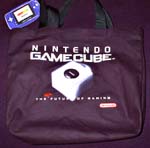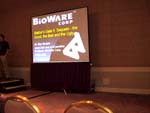|
March 23: Day Two

|
| Nintendo's GDC Gamecube Bag |
|
We returned to San Jose the following day to continue the Conference. We entered the Convention Center this second day with questions in our minds, notes on our schedules and ultra-stylish Nintendo tote-bags over our shoulders. Having purged all the "getting lost" abilities from ourselves during yesterday's dizzying driving route, we managed to get their early, in spite of the ever-thickening traffic.
In order to maximize the number of discussions and conferences we were able to attend and cover, we decided to split up for the day. As Andrew hurried off to a massive keynote speech from Maxis' Will Wright in the Civic Auditorium, I headed down the street to the Fairmont Hotel, where Bioware's co-founder and CEO, Ray Muzyka, was setting up for his 10:30 talk in a small suite on the second floor.
Baldur's Gate II & Sequels: The Good, the Bad & the Ugly
In addition to the previously mentioned positions, Ray Muzyka is also known among fans as the producer in charge of Baldur's Gate and the co-producer of Baldur's Gate II. He is also currently co-producing the upcoming Neverwinter Nights. His talk focused on what went into the production of Baldur's Gate II, and how the development process changed based on what the team learned while making the first title.

|
| Bioware's Presentation |
|
Bioware is composed of about 36 employees, usually in the process of creating between three to five titles at a time. These numbers have grown significantly since the company's beginning in 1995 and the release of the first Baldur's Gate. Following the title's completion, Bioware began licensing out the game's engine (dubbed the "Infinity Engine") to other companies, leading to such titles as Black Isle Studios' Icewind Dale. When the decision was made to work on a Baldur's Gate sequel, the team felt that these other games had raised the bar of what the engine was capable of, and that the engine would need an upgrade if Baldur's Gate II was going to truly stand out among other RPG titles.
Muzyka mentioned that, without this engine upgrade, Baldur's Gate II would have taken no longer to complete than the expansion pack for the first game, Tales of the Sword Coast. However, the entire team felt the need to improve. 6 programers, 12 artists, 4 producers, 6 quality assurance and 8 designers worked to create Bioware's sequel title, a process which would take more than 16 months. The team recognized that it was important not only to evaluate the process they took in creating the first title, but to learn from it before setting out to work on the second. In Baldur's Gate, the team was not only creating game content, but developing the Infinity Engine at the same time. This was too much work, and thus the sequel's development process was kept simple and straightforward wherever possible.
There were worries that Baldur's Gate II was going to be too short. As fans know, this is far from a problem. With 293 separate quests, each requiring between thirty minutes to ten hours to complete, the game can take more than 250 hours to finish in its entirety. In retrospect, Muzyka feels that the game was actually too long. It's massive length made the testing process a nightmare, and resulted in more than 15,000 bugs that needed fixing. Bioware also had several game elements which didn't make it into the final version. During the presentation, we were shown some of the original unedited FMV movie shots from the title, including blood stains and severed limbs and heads, all of which had to be removed to keep censors happy and ship the game. As well, the team wanted to include a deathmatch mode for the multiplayer game. While this is actually completed, it is still very buggy, and would require some work before any possible release. So it's still possible that fans may see it someday.
It was fascinating and entertaining to hear the lessons they had learned the hard way during the game's development process, and how these lessons were applied to the next title. Further, lessons learned from Baldur's Gate II are certainly being applied to Neverwinter Nights, due out near the end of this year. This title will include development tools, an in-game DM plan, and many other exciting features, including the ability to have 64 players together in a single session. Also, Baldur's Gate II players can look forward to Throne of Baal, the upcoming expansion set for that title.
Mac OSX: 3D Modeling & Rendering Techniques

|
| Maya running on OSX |
|
My next stop had less to do with games than most of the conferences, but I was excited about it for two reasons. First of all, it was focused entirely on what I am currently studying at school. And second, it showcased two software packages that had never before been shown to the public in their current stage of development.
For those who aren't familiar with 3D programs, it should be understood that Maya and Lightwave are two of the major applications used in the 3D modeling and animation industry. While Lightwave has been on the Macintosh platform for quite some time, Maya is making its first appearance at version 3.0 on OSX, Apple's blindingly quick, revolutionary unix-based operating system. Both programs were beyond impressive, with features that are going to change the face of both animation and game production.
Lightwave's new features are oriented towards bringing games to a new level of realism. Using complex lighting and texture maps, it is able to raise the look and feel of a title to cinematic quality. As well, the program is very easy to use, and outputs directly to a game's 3D engine, using a highly advanced polygon setup. That means that what you see in the program is exactly what you're going to see in the game. We've seen the advent of a whole new level in both console and computer technology, and tools like these are going to let game developers make the most of it. Owners of Lightwave 6.5 can head over to NewTek's site to download the fully carbonized OSX version for free.
Maya was looking pretty impressive, as well. A whole new system of realism had been added to the animation process, eliminating the need for keyframes in some scenarios. For instance, a stack of boxes can be set up, with a large wrecking ball hanging over them. The user can specify the mass of each object, and turn on gravity, and the wrecking ball will fly down and knock the boxes over in a level of realism that simply cannot be reproduced by keyframing. As well, Maya for OSX looks to be devoid of the glitches and bugs that can make the PC and Unix versions nearly unusable. As well, it was stated more than once that Alias/Wavefront, the makers of Maya, "have a very good relationship with Invidia." We'll have to wait to find out exactly what this means, but one can imagine what wonders might come from a union of one of the most advanced 3D software teams and the company who currently makes the most powerful graphics card in the world. Maya 4.0 recently went beta, and will be available later this year, while Maya for OSX should ship by June.
Iomega's Zip Drive and the PlayStation2

|
| Iomega's Zip Drive connected to a PS2 |
|
Iomega had something very interesting for show at their booth. Check out the image at left. That's a standard PC-compatible USB Zip Drive, and it's plugged right into the PlayStation2. Did you think the standard 8 meg memory card that comes with the PS2 was big? Well, get ready for something that can store more than 30 times that.
Iomega has virtually phased out the disc drive as we once knew it, offering a data storage solution with their Zip Drives that is great enough to meet the demands of today's file sizes. Now, PS2 owners will be able to utilize these spacious and speedy discs, and can even use the external zip drives they may already own. While I was there, Allison Berlin, an Iomega representative, was kind enough to give me a demo of the new setup in action. The PlayStation2 was running Unreal tournament, with the zip drive connected to one of the machine's USB ports. On a standard 100 meg Zip Disc was an additional map for the game, in the exact same format that would be used with the Mac or PC version of the first-person shooter. It was placed in the drive, and in about two seconds, the new level showed up as playable in the game.

|
| More fun at Iomega's booth |
|
Now, this is all quite simple, but at the same time, it is absolutely revolutionary. Consider the possibilities: aside from having endless storage space without having to shell out money for memory cards, we now have a quick and completely painless manner of transferring data and saved games between the PlayStation2 console and our computers. Using the PS2's hard drive, this process will be even easier. Imagine console games with endless replay options; just download some new levels or characters or any other manner of add-on, pop in the disc, and go play! Further, gaming titles can also use this to become completely cross-platform. While such things are commonplace to the computer gaming world, they represent a great advancement in console gaming.
Granted, developers would have to specifically implement the Zip Drive compatibility into their games, as I saw in Unreal Tournament. To make sure this is not an issue, Iomega is currently working with a number of big-name companies, and seemed very optimistic of a third quarter release of the final product. Dreamcast owners might recall that a similar idea was at one time planned for their system, but was never carried through. As well, Iomega isn't really thinking about any other consoles at this time. Watch for Iomega to begin adding to the gaming revolution later this year. I thanked them for taking time out to talk to me, and grabbed a few of their wonderful pins to add to my collection.
GDC Job Fair

|
| At the GDC Job Fair |
|
Before calling it a day, we spent some time at the Game Developers Conference Job Fair, where big name companies such as Electronic Arts, Verant, Konami and Invidia were all providing employment information. As well, they were handing out plenty of good stuff. Free t-shirts, posters, and even a laptop modem adapter were all there for the taking. As well, the press were treated to free lunches, and a huge screen and blasting sound system presented some of the most impressive FMVs and gameplay footage in gaming history.
Tomorrow will be a short day for me, but I am looking forward to the talk I have planned to attend. As well, I will soon be posting a comprehensive photo gallery of our entire GDC experience.
Matthew Wanlin
merripen@rpgamer.com
|









